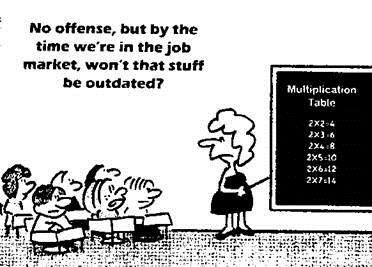2017年12月英语四级考试样卷
2017年12月英语四级考试样卷今天要为大家推送的是这份2017年四级样卷,备考是模拟题都不能放过的哟!做起来!
Part I Writing (30 minutes)
Directions: For this part, you are allowed 30 minutes to write an essay. You should start your essay with a brief description of the picture and then express your views on the importance of learning basic skills. You should write at least 120 words but no more than 180 words. Write your essay on Answer Sheet 1.
注意:此部分试题请在答题卡1上作答。
Part II Listening Comprehension (25 minutes)
Section A
Directions: In this section, you will hear three news reports. At the end of each news report, you will hear two or three questions. Both the news report and the questions will be spoken only once. After you hear a question, you must choose the best answer from the four choices marked A), B), C) and D). Then mark the corresponding letter on Answer Sheet 1 with a single line through the centre.
Questions 1 and 2 will be based on the following news item.
1. A) Christmas-time attacks made by Somali rebels.
B) An explosion at a bus station in central Nairobi.
C) The killing of more than 70 Ugandans in Kampala.
D) Blasts set off by a Somali group in Uganda’s capital.
2. A) On Christmas Eve.
B) Just before midnight.
C) During a security check.
D) In the small hours of the morning.
Questions 3 and 4 will be based on the following news item.
3. A) It is likely to close many of its stores.
B) It is known for the quality of its goods.
C) It remains competitive in the recession.
D) It will expand its online retail business.
4. A) Expand its business beyond groceries.
B) Fire 25,000 of its current employees.
C) Cut its DVD publishing business.
D) Sell the business for one pound.
Questions 5 to 7 will be based on the following news item.
5. A) All taxis began to use meters.
B) All taxis got air conditioning.
C) Advertisements were allowed on taxis.
D) Old taxis were replaced with new cabs.
6. A) A low interest loan scheme.
B) Environmentalists’ protests.
C) Taxi passengers’ complaints.
D) Permission for car advertising.
7. A) There are no more irregular practices.
B) All new cabs provide air-conditioning.
C) New cabs are all equipped with meters.
D) New legislation protects consumer rights.
Section B
Directions: In this section, you will hear two long conversations. At the end of each conversation, you will hear four questions. Both the conversation and the questions will be spoken only once. After you hear a question, you must choose the best answer from the four choices marked A), B), C) and D). Then mark the corresponding letter on Answer Sheet 1 with a single line through the centre.
Conversation One
Questions 8 to 11 are based on the conversation you have just heard.
8. A) It has a partnership with LCP.
B) It is headquartered in London.
C) It specializes in safety from leaks.
D) It has a chemical processing plant.
9.A) He is a chemist.
B) He is a salesman.
C) He is a safety inspector.
D) He is Mr. Grand’s friend.
10.A) The public relations officer.
B) Mr. Grand’s personal assistant.
C) Director of the safety department.
D) Head of the personnel department.
11. A) Wait for Mr. Grand to call back.
B) Leave a message for Mr. Grand.
C) Provide details of their products and services.
D) Send a comprehensive description of their work.
Conversation Two
Questions 12 to 15 are based on the conversation you have just heard.
12. A) Teacher.
B) Journalist.
C) Editor.
D) Typist.
13. A) Some newly discovered scenic spot.
B) Big changes in the Amazon valley.
C) A new railway under construction.
D) The beautiful Amazon rainforests.
14. A) In news weeklies.
B) In a local evening paper.
C) In newspapers’ Sunday editions.
D) In overseas editions of U.S. magazines.
15. A) To become a professional writer.
B) To be employed by a newspaper.
C) To get her life story published soon.
D) To sell her articles to a news service.
Section C
Directions: In this section, you will hear three passages. At the end of each passage, you will hear some questions. Both the passage and the questions will be spoken only once. Afteryou hear a question, you must choose the best answer from the four choices marked A), B), C) and D). Then mark the corresponding letter on Answer Sheet 1 with a single line through the centre.
Passage One
Questions 16 to 18 are based on the passage you have just heard.
16. A) She is both a popular and a highly respected author.
B) She is the first writer to focus on the fate of slaves.
C) She is the most loved African novelist of all times.
D) She is the most influential author since the 1930’s.
17.A) The Book Critics Circle Award.
B) The Nobel Prize for literature.
C) The Pulitzer Prize for fiction.
D) The National Book Award.
18. A) She is a relative of Morrison’s.
B) She is a slave from Africa.
C) She is a skilled storyteller.
D) She is a black woman.
Passage Two
Questions 19 to 21 are based on the passage you have just heard.
19. A) They are very generous in giving gifts.
B) They refuse gifts when doing business.
C) They regard gifts as a token of friendship.
D) They give gifts only on special occasions.
20. A) They enjoy giving gifts to other people.
B) They spend a lot of time choosing gifts.
C) They have to follow many specific rules.
D) They pay attention to the quality of gifts.
21.A) Gift-giving plays an important role in human relationships.
B) We must be aware of cultural differences in giving gifts.
C) We must learn how to give gifts before going abroad.
D) Reading extensively can make one a better gift-giver.
Passage Three
Questions 22 to 25 are based on the passage you have just heard.
22.A) She tenderly looked after her sick mother.
B) She developed a strong interest in finance.
C) She learned to write for financial newspapers.
D) She invested in stocks and shares on Wall Street.
23.A) She inherited a big fortune from her father.
B) She sold her restaurant with a substantial profit.
C) She got 7.5 million dollars from her ex-husband.
D) She made a wise investment in real estate.
24.A) She was dishonest in business dealings.
B) She frequently ill-treated her employees.
C) She abused animals including her pet dog.
D) She was extremely mean with her money.
25.A) She carried on her family’s tradition.
B) She made huge donations to charities.
C) She built a hospital with her mother’s money.
D) She made a big fortune from wise investments.
Part III Reading Comprehension (40 minutes)
Section A
Directions: In this section, there is a passage with ten blanks. You are required to select one word for each blank from a list of choices given in a word bank following the passage. Read the passage through carefully before making your choices. Each choice in the bank is identified by a letter. Please mark the corresponding letter for each item on Answer Sheet 2 with a single line through the centre. You may not use any of the words in the bank more than once.
Questions 36 to 45 are based on the following passage.
One in six. Believe it or not, that’s the number of Americans who struggle with hunger. To make tomorrow a little better, Feeding America, the nation’s largest(36) hunger-relief organization, has chosen September as Hunger Action Month. As part of its 30 Ways in 30 Days program, it’s asking (37) across the country to help the more than 200 food banks and 61,000 agencies in its network provide low-income individuals and families with the fuel they need to (38) .
It’s the kind of work that’s done every day at St. Andrew’s Episcopal Church in San Antonio. People who (39) at its front door on the first and third Thursdays of each month aren’t looking for God – they’re there for something to eat. St. Andrew’s runs a food pantry (食品室) that (40) the city and several of the(41) towns. Janet Drane is its manager.
In the wake of the (42) , the number of families in need of food assistance began to grow. It is (43) that 49 million Americans are unsure of where they will find their next meal. What’s most surprising is that 36% of them live in (44) where at least one adult is working. “It used to be that one job was all you needed,” says St. Andrew’s Drane. “The people we see now have three or four part-time jobs and they’re still right on the edge(45) .”
注意:此部分试题请在答题卡2上作答。
A) accumulate
B) circling
C) communities
D) competition
E) domestic
F) financially
G) formally
H) gather
I) households
J) recession
K) reported
L) reviewed
M) serves
N) surrounding
O) survive
Section B
Directions: In this section, you are going to read a passage with ten statements attached to it. Each statement contains information given in one of the paragraphs. Identify the paragraph from which the information is derived. You may choose a paragraph more than once. Each paragraph is marked with a letter. Answer the questions by marking the corresponding letter on Answer Sheet 2.
Universities Branch Out
A)
As never before in their long history, universities have become instruments of national competition as well as instruments of peace. They are the place of the scientific discoveries that move economies forward, and the primary means of educating the talent required to obtain and maintain competitive advantage. But at the same time, the opening of national borders to the flow of goods, services, information and especially people has made universities a powerful force for global integration, mutual understanding and geopolitical stability.
B)
In response to the same forces that have driven the world economy, universities have become more self-consciously global: seeking students from around the world who represent the entire range of cultures and values, sending their own students abroad to prepare them for global careers, offering courses of study that address the challenges of an interconnected world and collaborative (合作的) research programs to advance science for the benefit of all humanity.
C)
Of the forces shaping higher education none is more sweeping than the movement across borders. Over the past three decades the number of students leaving home each year to study abroad has grown at an annual rate of 3.9 percent, from 800,000 in 1975 to 2.5 million in 2004. Most travel from one developed nation to another, but the flow from developing to developed countries is growing rapidly. The reverse flow, from developed to developing countries, is on the rise, too. Today foreign students earn 30 percent of the doctoral degrees awarded in the United States and 38 percent of those in the United Kingdom. And the number crossing borders for undergraduate study is growing as well, to 8 percent of the undergraduates at America’s best institutions and 10 percent of all undergraduates in the U.K. In the United States, 20 percent of the newly hired professors in science and engineering are foreign-born, and in China many newly hired faculty members at the top research universities received their graduate education abroad.
D)
Universities are also encouraging students to spend some of their undergraduate years in another country. In Europe, more than 140,000 students participate in the Erasmus program each year, taking courses for credit in one of 2,200 participating institutions across the continent. And in the United States, institutions are helping place students in summer internships (实习) abroad to prepare them for global careers. Yale and Harvard have led the way, offering every undergraduate at least one international study or internship opportunity—and providing the financial resources to make it possible.
E)
Globalization is also reshaping the way research is done. One new trend involves sourcing portions of a research program to another country. Yale professor and Howard Hughes Medical Institute investigator Tian Xu directs a research center focused on the genetics of human disease at Shanghai’s Fudan University, in collaboration with faculty colleagues from both schools. The Shanghai center has 95 employees and graduate students working in a 4,300-square-meter laboratory facility. Yale faculty, postdoctors and graduate students visit regularly and attend videoconference seminars with scientists from both campuses. The arrangement benefits both countries; Xu’s Yale lab is more productive, thanks to the lower costs of conducting research in China, and Chinese graduate students, postdoctors and faculty get on-the-job training from a world-class scientist and his U.S. team.
F)
As a result of its strength in science, the United States has consistently led the world in the commercialization of major new technologies, from the mainframe computer and the integrated circuit of the 1960s to the Internet infrastructure (基础设施) and applications software of the 1990s. The link between university-based science and industrial application is often indirect but sometimes highly visible: Silicon Valley was intentionally created by Stanford University, and Route 128 outside Boston has long housed companies spun off from MIT and Harvard. Around the world, governments have encouraged copying of this model, perhaps most successfully in Cambridge, England, where Microsoft and scores of other leading software and biotechnology companies have set up shop around the university.
G)
For all its success, the United States remains deeply hesitant about sustaining the research-university model. Most politicians recognize the link between investment in science and national economic strength, but support for research funding has been unsteady. The budget of the National Institutes of Health doubled between 1998 and 2003, but has risen more slowly than inflation since then. Support for the physical sciences and engineering barely kept pace with inflation during that same period. The attempt to make up lost ground is welcome, but the nation would be better served by steady, predictable increases in science funding at the rate of long-term GDP growth, which is on the order of inflation plus 3 percent per year.
H)
American politicians have great difficulty recognizing that admitting more foreign students can greatly promote the national interest by increasing international
understanding. Adjusted for inflation, public funding for international exchanges and foreign-language study is well below the levels of 40 years ago. In the wake of September 11, changes in the visa process caused a dramatic decline in the number of foreign students seeking admission to U.S. universities, and a corresponding surge in enrollments in Australia, Singapore and the U.K. Objections from American university and business leaders led to improvements in the process and a reversal of the decline, but the United States is still seen by many as unwelcoming to international students.
I)
Most Americans recognize that universities contribute to the nation’s well-being through their scientific research, but many fear that foreign students threaten American competitiveness by taking their knowledge and skills back home. They fail to grasp that welcoming foreign students to the United States has two important positive effects: first, the very best of them stay in the States and—like immigrants throughout history—strengthen the nation; and second, foreign students who study in the United States become ambassadors for many of its most cherished (珍视) values when they return home. Or at least they understand them better. In America as elsewhere, few instruments of foreign policy are as effective in promoting peace and stability as welcoming international university students.
注意:此部分试题请在答题卡2上作答。
46.American universities prepare their undergraduates for global careers by giving them chances for international study or internship.
47.Since the mid-1970s, the enrollment of overseas students has increased at an annual rate of 3.9 percent.
48.The enrollment of international students will have a positive impact on America rather than threaten its competitiveness.
49.The way research is carried out in universities has changed as a result of globalization.
50.Of the newly hired professors in science and engineering in the United States, twenty percent come from foreign countries.
51.The number of foreign students applying to U.S. universities decreased sharply after September 11 due to changes in the visa process.
52.The U.S. federal funding for research has been unsteady for years.
53.Around the world, governments encourage the model of linking university-based science and industrial application.
54.Present-day universities have become a powerful force for global integration.
55.When foreign students leave America, they will bring American values back to their home countries.
Section C
Directions: There are 2 passages in this section. Each passage is followed by some questions or unfinished statements. For each of them there are four choices marked A), B), C) and D). You should decide on the best choice and mark the corresponding letter on Answer Sheet 2 with a single line through the centre.
Passage One
Questions 56 to 60 are based on the following passage.
Global warming is causing more than 300,000 deaths and about $125 billion in economic losses each year, according to a report by the Global Humanitarian Forum, an organization led by Kofi Annan, the former United Nations secretary general.
The report, to be released Friday, analyzed data and existing studies of health, disaster, population and economic trends. It found that human-influenced climate change was raising the global death rates from illnesses including malnutrition (营养不良) and heat-related health problems.
But even before its release, the report drew criticism from some experts on climate and risk, who questioned its methods and conclusions.
Along with the deaths, the report said that the lives of 325 million people, primarily in poor countries, were being seriously affected by climate change. It projected that the number would double by 2030.
Roger Pielke Jr., a political scientist at the University of Colorado, Boulder, who studies disaster trends, said the Forum’s report was “a methodological embarrassment” because there was no way to distinguish deaths or economic losses related to human-driven global warming amid the much larger losses resulting from the growth in populations and economic development in vulnerable (易受伤害的) regions. Dr. Pielke said that “climate change is an important problem requiring our utmost attention.” But the report, he said, “will harm the cause for action on both climate change and disasters because it is so deeply flawed (有瑕疵的).”
However, Soren Andreasen, a social scientist at Dalberg Global Development Partners who supervised the writing of the report, defended it, saying that it was clear that the numbers were rough estimates. He said the report was aimed at world leaders, who will meet in Copenhagen in December to negotiate a new international climate treaty.
In a press release describing the report, Mr. Annan stressed the need for the negotiations to focus on increasing the flow of money from rich to poor regions to help reduce their vulnerability to climate hazards while still curbing the emissions of the heat-trapping gases. More than 90% of the human and economic losses from climate change are occurring in poor countries, according to the report.
注意:此部分试题请在答题卡2上作答。
56. What is the finding of the Global Humanitarian Forum?
A) Rates of death from illnesses have risen due to global warming.
B) Global temperatures affect the rate of economic development.
C) Malnutrition has caused serious health problems in poor countries.
D) Economic trends have to do with population and natural disasters.
57. What do we learn about the Forum’s report from the passage?
A) It caused a big stir in developing countries.
B) It was warmly received by environmentalists.
C) It aroused a lot of interest in the scientific circles.
D) It was challenged by some climate and risk experts.
58. What does Dr. Pielke say about the Forum’s report?
A) Its statistics look embarrassing.
B) It deserves our closest attention.
C) It is invalid in terms of methodology.
D) Its conclusion is purposely exaggerated.
59. What is Soren Andreasen’s view of the report?
A) Its conclusions are based on carefully collected data.
B) It is vulnerable to criticism if the statistics are closely examined.
C) It will give rise to heated discussions at the Copenhagen conference.
D) Its rough estimates are meant to draw the attention of world leaders.
60. What does Kofi Annan say should be the focus of the Copenhagen conference?
A) How human and economic losses from climate change can be reduced.
B) How rich countries can better help poor regions reduce climate hazards.
C) How emissions of heat-trapping gases can be reduced on a global scale.
D) How rich and poor regions can share responsibility in curbing global warming.
Passage Two
Questions 61 to 65 are based on the following passage.
It’s an annual argument. Do we or do we not go on holiday? My partner says no because the boiler could go, or the roof fall off, and we have no savings to save us. I say you only live once and we work hard and what’s the point if you can’t go on holiday. The joy of a recession means no argument next year – we just won’t go.
Since money is known to be one of the things most likely to bring a relationship to its knees, we should be grateful. For many families the recession means more than not booking a holiday. A YouGov poll of 2,000 people found 22% said they were arguing more with their partners because of concerns about money. What’s less clear is whether divorce and separation rates rise in a recession – financial pressures mean couples argue more but make splitting up less affordable. A recent research shows arguments about money were especially damaging to couples. Disputes were characterised by intense verbal (言语上的) aggression, tended to be repeated and not
resolved, and made men, more than women, extremely angry.
Kim Stephenson, an occupational psychologist, believes money is such a big deal because of what it symbolises, which may be different things to men and women. “People can say the same things about money but have different ideas of what it’s for,” he explains. “They’ll say it’s to save, to spend, for security, for freedom, to show someone you love them.” He says men are more likely to see money as a way of buying status and of showing their parents that they’ve achieved something.
“The biggest problem is that couples assume each other knows what’s going on with their finances, but they don’t. There seems to be more of a taboo (禁忌) about talking about money than about death. But you both need to know what you’re doing, who’s paying what into the joint account and how much you keep separately. In a healthy relationship, you don’t have to agree about money, but you have to talk about it.”
注意:此部分试题请在答题卡2上作答。
61. What does the author say about vacationing?
A) People enjoy it all the more during a recession.
B) Few people can afford it without working hard.
C) It is the chief cause of family disputes.
D) It makes all the hard work worthwhile.
62. What does the author mean by saying “money is known ... to bring a relationship to its knees” (Lines 1-2, Para. 2)?
A) Money is considered to be the root of all evils.
B) Disputes over money may ruin a relationship.
C) Few people can resist the temptation of money.
D) Some people sacrifice their dignity for money.
63. The YouGov poll of 2,000 people indicates that in a recession ________.
A) couples show more concern for each other
B) it is more expensive for couples to split up
C) conflicts between couples tend to rise
D) divorce and separation rates increase
64. What does Kim Stephenson believe?
A) Men and women view money in different ways.
B) Money is often a symbol of a person’s status.
C) Men and women spend money on different things.
D) Money means a great deal to both men and women.
65. The author suggests at the end of the passage that couples should ________.
A) put their money together instead of keeping it separately
B) discuss money matters to maintain a healthy relationship
C) make efforts to reach agreement on their family budgets
D) avoid arguing about money matters to remain romantic
Part IV Translation (30 minutes)
Directions: For this part, you are allowed 30 minutes to translate a passage from Chinese into English. You should write your answer on Answer Sheet 2.
剪纸(paper cutting)是中国最为流行的传统民间艺术形式之一。中国剪纸有一千五百多年的历史,在明朝和清朝时期(the Ming and Qing Dynasties)特别流行。人们常用剪纸美化居家环境。特别是在春节和婚庆期间,剪纸被用来装饰门窗和房间,以增加喜庆的气氛。剪纸最常用的颜色是红色,象征健康和兴旺。中国剪纸在世界各地很受欢迎,经常被用作馈赠外国友人的礼物。
注意:此部分试题请在答题卡2上作答。
听力原文
Tape Script of Listening Comprehension
Section A
Directions: In this section, you will hear three news reports. At the end of each news report, you will hear two or three questions. Both the news report and the questions will be spoken only once. After you hear a question, you must choose the best answer from the four choices marked A), B), C) and D). Then mark the corresponding letter on Answer Sheet 1 with a single line through the centre.
Questions 1 and 2 will be based on the following news item.
Kenyan police say one person was killed and 26 injured in an explosion at a bus station in central Nairobi. The blast hit a bus about to set off for the Ugandan capital Kampala. Last July, the Somali group al-Shabab said it was behind the blasts in the Ugandan capital which killed more than 70 people. Will Ross reports from the Kenyan capital.






 6大原则搞定专四写作
6大原则搞定专四写作 完整的1个月托福备考
完整的1个月托福备考 专四必看系列:考前作
专四必看系列:考前作 2017年12月大学英语四
2017年12月大学英语四 修辞与翻译:明喻、暗
修辞与翻译:明喻、暗 四级阅读:仔细阅读答
四级阅读:仔细阅读答 CATTI考试英语口译二
CATTI考试英语口译二 四六级备考可以从这6
四六级备考可以从这6 2017四级翻译范文及解
2017四级翻译范文及解 表达否定的常见翻译方
表达否定的常见翻译方 2017专四词汇必备:高
2017专四词汇必备:高 雅思听力学习:四类听
雅思听力学习:四类听 2017年5月英语四级口
2017年5月英语四级口 2016年12月英语四级阅
2016年12月英语四级阅 新改革英语六级听力练
新改革英语六级听力练 英语四级作文:万能段
英语四级作文:万能段






